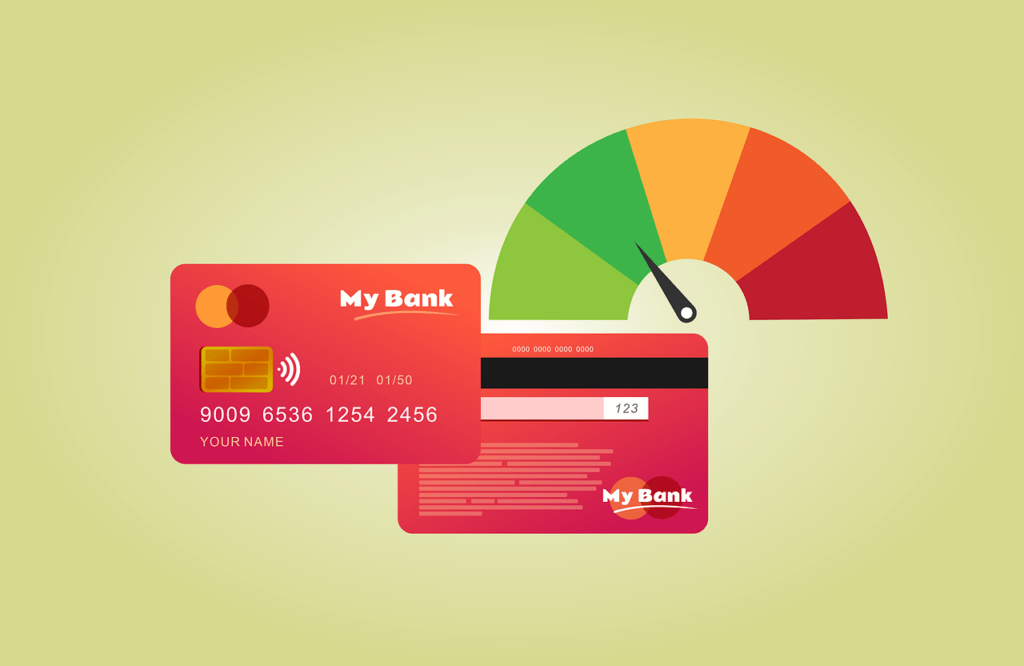A high credit score can make your adulthood easier in many ways. Thinking about it early is an excellent way to maximize the benefits of a strong credit profile and boost your financial stability.
The first step toward credit building is learning the answer to a simple question—“What is a credit score?” Kids’ definition, calculation methods, and all important details are explained in this guide. You’ll learn what score to aim for and how to secure it by managing your money wisely.
Credit Score—Definition for Kids
A credit score is a three-digit number that shows how responsible you are with the money you borrow from a bank. Whenever you want to obtain a loan or buy something in installments, your credit score will determine if you can do it and on what terms.
The higher your score, the better your chances of borrowing money because lenders won’t see you as a risk. Beyond getting additional funds when you need them, good credit can help you buy a car, rent or buy your desired apartment, and get a job in certain industries.
Credit scores range between 300 and 850. You’ll get your starting score at least six months after taking out your first credit product, and it will evolve with time, depending on your spending behavior and overall financial responsibility.
What Is a Good Credit Score?

Source: PabitraKaity
Credit scores are split into five categories with descriptive grades—here is how they typically range:
| Category | Score |
| Poor | <580 |
| Fair | 580–669 |
| Good | 670–739 |
| Very Good | 740–779 |
| Exceptional | 780+ |
Any score above 670 should make you eligible for most loans. Still, you should aim as high as possible because a higher score means better loan terms, such as lower interest rates and longer repayment periods.
You shouldn’t have trouble securing a good score, as your first one will likely be between 500 and 700 if you use your first credit product wisely and don’t make any reckless financial decisions. Estimating the exact score you’ll start with and predicting how it will change is challenging, as there are several factors to consider.
Who Calculates Your Credit Score and How
The three major consumer credit bureaus are responsible for calculating credit scores:
- Equifax
- Experian
- TransUnion
When you want to get a loan or other financial product, the lender will get your credit report from the bureau to assess your score and check for any red flags.
Credit bureaus calculate scores based on the two most popular scoring models:
- FICO®
- VantageScore®
FICO
The FICO scoring model is the most popular—so much so that people often use the terms “credit score” and “FICO score” interchangeably. There are several versions of the FICO model, with FICO Score 8 being the most widely used.
This model relies on five factors to calculate your score, each carrying a specific weight expressed in percentage values. The following table breaks down the factors and their impact on the score:
| Factor | Explanation | Credit Score Impact |
| Payment history | It’s a record of your past repayments showing whether they were made on time, late, or missed. This factor has the largest impact on your score | 35% |
| Amount owed/Credit utilization | The amount owed for loans is how much you owe each lender individually and in aggregate (total). Credit utilization for credit cards is how much of your credit limit you are using, expressed as a percentage—e.g., $300 used of a $1,000 credit limit is 30% utilization. Credit card utilization below 30% is good, and below 10% is ideal | 30% |
| Credit history length | This factor refers to the amount of time you’ve been using financial products—the longer your credit history, the better | 15% |
| New credit | It shows recent credit accounts and hard inquiries. Note that applying for new credit too frequently or haphazardly might lower your score | 10% |
| Credit mix | Credit mix refers to the different types of credit accounts you have. Your account should have a mix of revolving (e.g., credit cards) and installment (loans with set monthly payments) accounts—this shows the lenders that you know how to responsibly handle multiple accounts | 10% |
VantageScore
Like FICO, VantageScore has evolved with time, with 4.0 being the latest version. Besides percentage weights, this model assigns influence levels to different credit score factors:
| Factor | Weight | Influence Level |
| Payment history | 41% | Extremely influential |
| Depth of credit | 20% | Highly influential |
| Credit utilization | 20% | Highly influential |
| Recent credit | 11% | Moderately influential |
| Balances | 6% | Less influential |
| Available credit | 2% | Less influential |
VantageScore shares some factors with FICO—payment history and recent credit. Others are slightly different and explained as follows:
- Depth of credit—It assesses the age of your credit accounts from three perspectives—oldest, youngest, and average. The oldest account gives lenders insight into your borrowing and repayment habits, helping them make a decision about lending you the money
- Balances—This factor considers the total balances on all your credit accounts, both current and delinquent
- Available credit—This category looks into the amount of unused credit on your revolving accounts. Keep in mind that larger amounts can raise your credit score slightly
Both VantageScore and FICO scores range from 300 to 850, so the only difference lies in the calculation methodology. Regardless of these differences, the rules for securing and maintaining a high credit score boil down to a few smart financial choices and habits.
How To Maximize Your Credit Score

Source: Mikhail Nilov
Borrowing money from a bank involves a great deal of responsibility. You’re spending someone else’s money that you have to repay, and any poor spending decisions damage your chances of getting future loans.
The good news is that such decisions are easily avoidable—you can build a remarkable credit profile by following a few simple tips:
- Make timely payments—Regardless of the scoring model, payment history is by far the most important determinant of your credit score. A single missed payment can stay on your report for up to seven years even if you make all other payments timely
- Use credit funds as a last resort—Ideally, your credit utilization won’t exceed 30%. Overspending borrowed money means that you don’t have a firm grasp of your finances, which is something every lender will hold against you
- Only apply for new credit when you need it—Opening new accounts or making hard inquiries haphazardly shows lenders that you have a constant need for additional funds and damages your reliability as a borrower
When To Start Building a Credit Score
Both credit scoring models look at your credit history length, so building credit early can give you a significant advantage. While this may seem like an adult matter, starting in your teens is highly recommended.
You may struggle to get started with credit, though, because minors and young adults typically don’t have access to financial products that help them build it. As imposed by the CARD Act of 2009, you can only get a credit card before turning 21 if you meet one of these conditions:
- You can prove that you can repay the debt independently
- You have a co-signer over 21 who can repay it if you’re unable to
Many children can’t check either box, so parents jump in by adding them to their credit cards as authorized users. In this case, you would get a credit profile sooner than you could independently. The problem is, you only build credit while you’re registered on the parent’s card. Once you’re removed, all credit history associated with the card gets deleted from your profile, so you’re back to square one.
Luckily, parents can opt for a more effective way of helping their children build credit—FreeKick.
FreeKick—Parent-Sponsored Credit Profile Building and Monitoring
Powered by Austin Capital Bank, FreeKick helps parents establish and build credit for their children ages 14–25. It does so through a combination of a Federal Deposit Insurance Corporation-insured (FDIC-insured) deposit account and additional services.
FreeKick offers three simple plans, letting parents avoid unnecessary monthly subscriptions:
- Free—One-time FDIC-insured deposit of $2,500
- $49/year—One-time FDIC-insured deposit of $1,750
- $99/year—One-time FDIC-insured deposit of $1,000
If you’re a parent wanting to help your child build credit, here’s all you need to do:
- Make a Deposit—Sign up and choose your plan
- Set It and Forget It—Once the account is activated, FreeKick automatically builds the child’s credit history over 12 months
- Keep Growing—After 12 months, you can renew the account to further improve your child’s credit or close it and get the deposit back
The child builds credit through a no-interest installment loan repaid using the deposited funds. Nobody can access the funds, so there’s no risk of defaults or other issues—you can rest assured your child will start with a solid credit profile.
FreeKick starts reporting credit history to the three major credit bureaus if the child is a legal adult (18 and over in most states). Minors’ credit history is built the same way, but it can only be reported once they reach legal age and activate reporting through a simple process.
You can close the account at any point, regardless of whether the 12-month term has ended. There are no cancellation penalties, but a minor’s credit history can’t be reported unless they come of age in the meantime because the bureaus only accept credit reporting for adults.
FreeKick’s Credit Profile Monitoring Gives Parents and Children Peace of Mind
In recent years, synthetic identity fraud has become one of the most prominent financial crimes in our payment system. Minors are among the main targets, as fraudsters use their Social Security numbers (SSNs) to create new identities and get loans without repaying them.
To ensure this doesn’t happen to their child, a parent would have to be on a constant lookout for danger. This is a time-consuming endeavor, and a typical parent doesn’t have access to all the necessary tools to safeguard their child’s private information.
FreeKick offers a helping hand through credit profile monitoring services included with the account.
If you’re a parent looking to make your child’s adulthood easier by helping them build credit and keep their private information safe, get started with FreeKick..
Featured image source: PiggyBank




